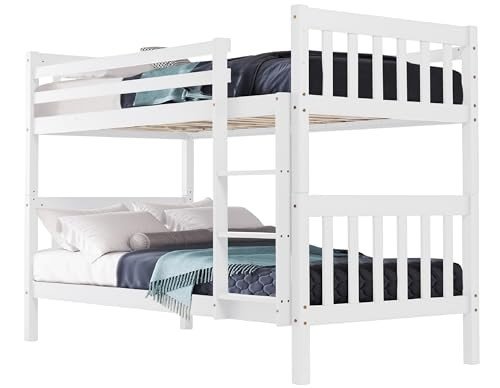The Three Greatest Moments In Bunk Beds History
Exploring Bunk Beds: A Comprehensive Guide
Bunk beds have actually long been a staple in children's bed rooms, dormitories, and even homes with limited space. Not only do they offer a practical sleeping option, but they also create a fun and creative environment for children and a great space-saver for adults and households. This article will explore everything you need to learn about bunk beds, from types and materials to security ideas and purchasing recommendations.
Table of Contents
- Kinds Of Bunk Beds
- Standard Bunk Beds
- Loft Beds
- Triple Bunk Beds
- L-Shaped Bunk Beds
- Product Options
- Wood
- Metal
- Security Considerations
- Buying Guide
- Frequently asked questions
Kinds Of Bunk Beds
Bunk beds can be found in different styles to match different needs and choices. Here's a breakdown of the most typical types:
Conventional Bunk Beds
Traditional bunks normally include 2 beds stacked vertically on top of one another. These beds are ideal for brother or sisters sharing a room or for taking full advantage of sleeping space in guest spaces.
Loft Beds
Loft beds stand similarly to standard bunk beds but do not have a lower sleeping location. Rather, they often incorporate a desk or seating location beneath, making them a great choice for little spaces needing multifunctionality.
Triple Bunk Beds
Triple bunk beds are designed for 3 occupants, with beds stacked in a three-tier configuration. These are less common but can be an enjoyable option for big households or pajama parties.
L-Shaped Bunk Beds
With one bed placed horizontally and the other vertically, L-shaped bunk beds are often geared up with additional functions such as desks or storage drawers and can match corner areas in a room.
Comparison of Bunk Bed Types
Bed Type
Ideal Use
Description
Standard
Shared bed rooms or guest rooms
Two beds stacked vertically
Loft
Little spaces needing multi-purpose space
Upper bed with open space underneath
Triple
Large households or sleepovers
3 beds stacked vertically
L-Shaped
Corner or flexible areas
A combination of vertical and horizontal beds
Product Options
Bunk beds are made from various products, with wood and metal being the most common. Each material has its benefits and drawbacks.
Wood
- Toughness: Generally robust and can endure years of use.
- Aesthetic Appeal: Offers a timeless look that can blend with numerous designs.
- Weight Capacity: Typically tougher; can support heavier weights.
- Downsides: May be more expensive than metal options and can be prone to scratches.
Metal
- Sturdiness: Generally light-weight and easy to move however still strong.
- Modern Design: Often can be found in sleek designs, making it appealing for contemporary areas.
- Affordable: Usually less expensive than wooden choices.
- Disadvantages: Can be cold to the touch in winters and may not have the very same visual appeal for some buyers.
Security Considerations
When it pertains to bunk beds, security can not be overlooked. Here are essential safety ideas to keep in mind:
- Guardrails: Ensure that the leading bunk has guardrails on both sides to avoid falls.
- Durable Construction: Check for a strong build and sturdy materials to hold up against weight and movement.
- Weight Limit: Adhere to the maker's weight limit for both the upper and lower bunks.
- Ladder Design: Choose bunks with a safe, easy-to-climb ladder and prevent any sharp edges or rungs.
- Age Restrictions: Most makers advise that kids under the age of six need to not sleep in the upper bunk.
Purchasing Guide
When searching for bunk beds, consider the following factors to discover the best suitable for your requirements:
- Space Availability: Measure the room size and ceiling height, making sure there is sufficient space for the top bunk.
- Bed Size: Decide in between twin, full, or bigger sizes based on your requirements and the size of the room.
- Design Preference: Consider the general design of the bed room to discover an ideal design.
- Relieve of Setup: Look for a bunk bed that is straightforward to assemble.
- Budget plan: Bunk beds can be found in various price varieties, so identify a budget before starting your search.
FAQs
1. What is Darla advised age for kids to sleep on the top bunk?
Kids aged 6 and older are normally advised to sleep on the leading bunk to minimize the risk of falls.
2. How can I make my bunk bed much safer?
To improve security, ensure guardrails are properly set up and check that the bed is put on a flat surface. Additionally, encourage children to utilize the ladder thoroughly.
3. Can I transform a bunk bed into 2 separate beds?
Lots of bunk beds are designed to be convertible. Inspect the manufacturer's requirements for convertibility functions.
4. What accessories are available for bunk beds?
Common accessories consist of bed linens, storage drawers, staircases rather of ladders, and tented canopies for an enjoyable visual appeal.
5. How do I maintain my bunk bed?
Regular look for loose screws or structural integrity can help guarantee safety. Dust the bed routinely and tidy spills quickly to keep the products in good condition.
Bunk beds are flexible and a space-efficient option for numerous living scenarios, from children's rooms to visitor lodgings. With lots of styles and materials readily available, possible purchasers have a wealth of options to think about, ensuring a mix of usefulness and looks. By focusing on security and following the tips outlined in this guide, individuals can discover the ideal bunk bed that matches their space and way of life, all while developing a pleasurable sleeping environment.
